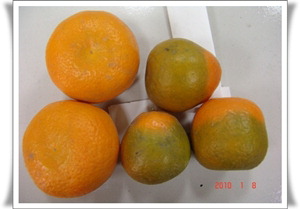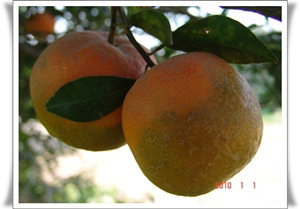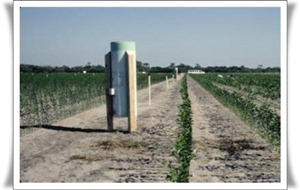Phase 3 (2007 Deadline)
Management of Greening by Producing Healthy Plants, Monitoring
Vectors, and Identification of Tolerance
Mikeal Roose, University of California, Riverside
Iqrar A. Khan, University of Agriculture, Faisalabad
Pakistani Funding (HEC): $ 245,000
US Funding (State): $ 159,500
Project Dates on US Side: July 1, 2008 - June 30, 2011
Project Overview
The primary objectives of this project were to (1) develop an infrastructure to treat local germplasm in Pakistan to ensure that it is free of greening; (2) evaluate citrus and related plants for greening resistance and tolerance; and (3) apply real-time PCR assays for detection of Huanglongbing (HLB) virus and citrus tristeza virus to study how the pathogens spread under different field conditions.
|

The devastating effects of greening are clearly visible in the oranges at right, compared with healthy fruit at left (photo courtesy of Mr. Muhammad Fakhar-ud-Din Razi).
|
|

Kinnow affected by greening (photo courtesy of Mr. Muhammad Fakhar-ud-Din Razi).
|
Major Results
- Eliminated HLB from infected budwood source trees of 50 different citrus varieties by antibiotic treatment
- Transferred seed of more than 150 citrus varieties to Pakistan to test for HLB resistance
- Discovered that Asian Citrus psyllids, which transmit HLB to citrus, survive very hot summer temperatures but insects are less active in Pakistan
- Transferred high-throughput qPCR methods and equipment to detect Candidatus Liberibacter asiaticus (CLas) in citrus and psyllids to Pakistani scientists
- Trained two PhD and three MSc students from Pakistan, with one student visiting Riverside for training in qPCR for CLas detection
Quarterly Update
|

A suction psyllid trap similar to the one shipped to UAF (photo courtesy of Dr. Richard Lee).
|
Muhammad Fakhar-ud-Din Razi, the PhD candidate from the University of Faisalabad who visited Riverside from August 2010 through February 2011, was awarded his PhD at UAF in June. As a result of work carried out during his visit, the presence of HLB in both plants and psyllids has been confirmed in Pakistan from his samples and DNA extractions by sequencing targeted conserved areas of the bacterial genome. The molecular analyses indicate the presence of two distinct populations of the bacterium associated with HLB in the main citrus production area of Pakistan. The sequences of both populations have a very high homology with Candidatus Liberibacter asiaticus, the bacterium associated with HLB in Florida. The data from psyllid traps and presence of the bacterium associated with HLB under different temperatures and different times of plant flushing have been analyzed, and the results are being prepared for publication. Meanwhile, research this past quarter in Riverside has been directed towards performing biological indexing for graft transmissible pathogens of citrus using very young seedling indicator plants in specialized pots called conetainers™. The final results are still pending, but this approach should allow for quicker production of seedling indicator plants. Currently indicator plants are grown for 12-18 months before being used for a biological index, but the new system allows them to be used for indexing at only about 4-5 months old.
Progress Report Summaries
Show all progress summaries | Hide progress summaries
2010 Show summary || Hide summary
In 2010 the partners on this project looked forward to the six-month visit of a Pakistan PhD student to Riverside beginning in the first quarter of the year. The student received training in the molecular characterization of HLB and detection of HLB in psyllids and plants. A second student from Pakistan visited Riverside later in the year to receive training on shoot tip grafting and thermotherapy of germplasm, and he worked in the research area of antibiotic/temperature treatments to eliminate greening from budwood and development of multiplex real time PCR for detection of multiple prokaryotic pathogens in citrus.
The infrastructure developed has resulted in a continuous exchange of information related to protocols to be followed for therapy of germplasm and indexing to verify freedom from graft transmissible pathogens in 2010. The research team also started evaluating germplasm of citrus and citrus relatives for resistance/tolerance/susceptibility to greening. Seed from 92 citrus varieties and relatives was shipped from Riverside, CA to University of Faisalabad in Pakistan. A similar field planting was established in Florida. In addition, a comprehensive survey was conducted in the citrus growing areas of the Punjab of Pakistan with records of psyllid populations and HLB symptoms being recorded. The third objective has progressed by the arrival of the PhD student from University of Agriculture, Faisalabad. The student had collected and extracted DNA from 179 HLB suspect or symptomatic citrus plants from the central Punjab, Pakistan. Information gathered during the 2009 and 2010 surveys will be utilized to reveal trends and differences between the host/insect/pathogen complex in Pakistan and in the U.S. (Florida).
Throughout the year 2010, the Riverside lab developed a high through-put extraction protocol for preparation of DNA for testing for HLB. This protocol will be carried back to Pakistan by PhD student upon his return in late February, 2011. Further details on project results and upcoming activities may be found in the annual progress report for 2010 linked near the top of this page.
2009 Show summary || Hide summary
In Pakistan, three groves were selected for monitoring in each of four major citrus growing regions, and five trees were tagged within each grove, with each being monitored weekly for psylla populations. All trees were scored for symptomatic presence of HLB virus, with a 9% incidence of HLB symptoms at the beginning of the observations. By the end of the first quarter of 2009, the U.S. partners had shipped seeds from 92 citrus varieties and related plants, and although about 5% of the seed samples were overly dry upon arrival and had to be recollected for reshipment, the rest were sown in a protected greenhouse in Faisalabad. Now that the seedlings are at the 6-12 leaf stage, they are ready to be moved from the greenhouse to the field. Five plants of each variety will be planted into the field in a replicated, random planting where they will be naturally exposed to HLB spread by the psyllid vector, Diaphorina citri.
A 2-meter-tall suction trap was shipped to the University of Faisalabad and was installed in the summer of 2009, and UAF upgraded its labs with a gel electrophoresis system, PCR machine, genetic analyzer, and several other pieces of equipment funded through this project. Arrangements have made to ship some of the psyllids from Faisalabad to Riverside, where they will be tested for presence of the bacterium associated with HLB using real time PCR, with similar tests to be conducted at UAF as well. Meanwhile, the postdoctoral researcher employed on the project in Riverside has been sequencing a 1.6 kb fragment of the nuclear gene, malate dehydrogenase, and is using the single nucleotide polymorphisms to determine the phylogenetic relationships among Citrus species and the citrus relatives. Some preliminary results were presented at the annual meeting of the American Phytopathological Society in July 2009 and at the Plant and Animal Genome XVIII Conference in San Diego in January 2010.
According to the US co-principal investigator Dr. Richard Lee, a more rapid method is needed to eliminate HLB from citrus germplasm so that the germplasm can be used as clean sources of buds for the propagation of healthy plants. Conventional thermotherapy of citrus has not been efficient and while shoot tip grafting works well, it is time consuming and requires a high level of expertise by the technician. Experiments began to study the use of antibiotics and/or heat therapy of budwood as a way to quickly eliminate HLB from budwood. In Riverside, the Candidatus Liberibacter associated with tomato psyllid yellows was utilized to determine the effectiveness of various antibiotics to eliminate this pathogen in tomato, and citrus stubborn, a phloem-limited spiroplasma disease endemic to California, was used as a model system to determine the tolerance of citrus to the antibiotics being tested and tolerance to different heat regimes and effectiveness in eliminating stubborn. The results from these preliminary trials have been transferred to cooperators in Pakistan for trials with citrus infected with HLB.
2008 Show summary || Hide summary
Back to Pakistan-US Science and Technology Program Phase 3 Grants List






